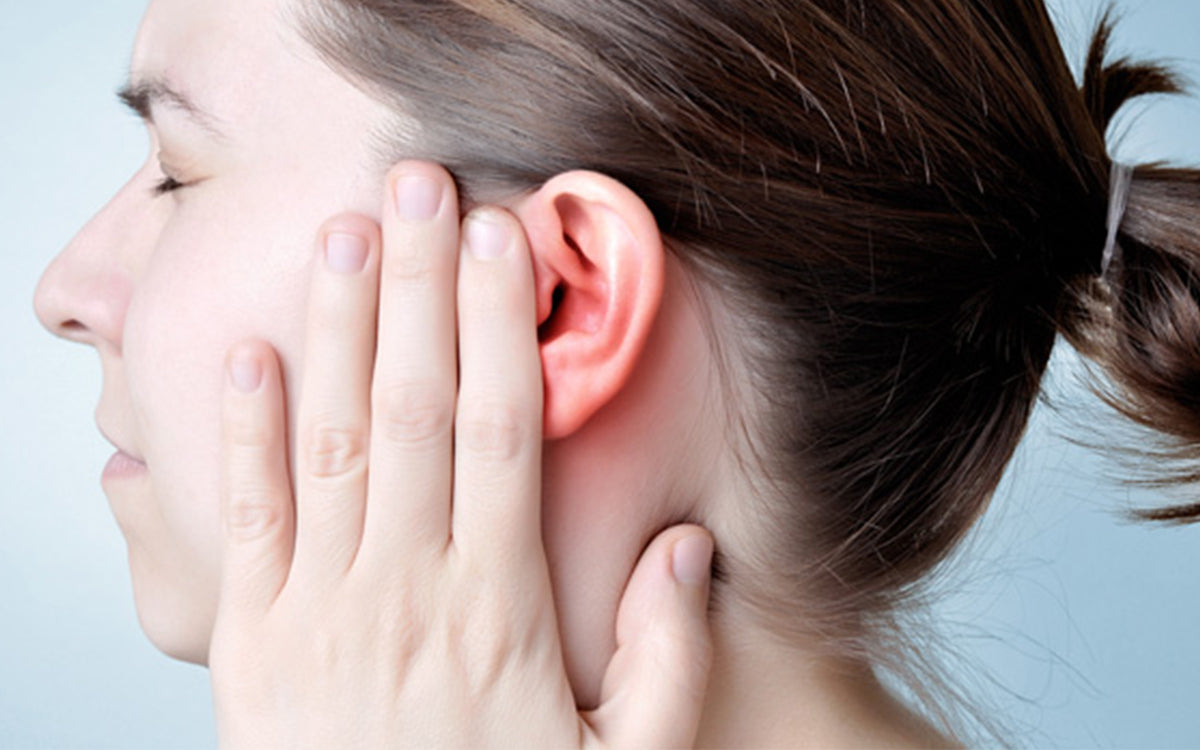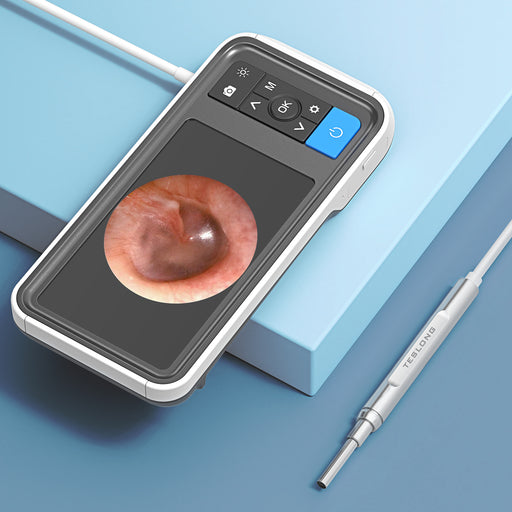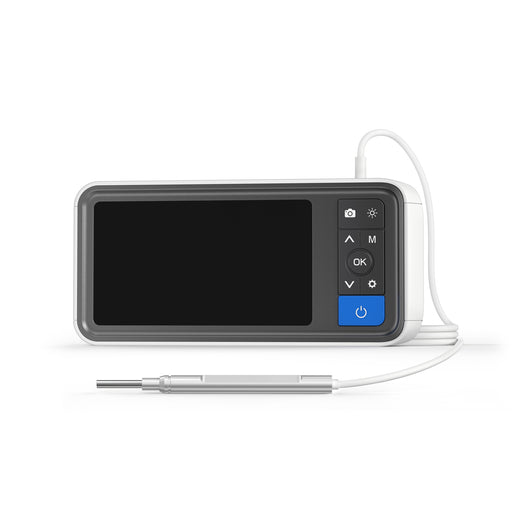
Otoscope for ear infection
Learn how to check for ear infection with a home otoscope
Otoscopes allow you to look inside your ear or someone else's ear to look for problems and excessive wax. Otoscopes are small, inexpensive devices useful for diagnosing diseases of the ear, nose, and throat. A good otoscope will give you years of reliable service if you use them properly and maintain them.
A smart ear infection camera is a tiny gadget with a camera on the tip and may be inserted into the ear canal. The otoscope is protected from penetrating too far into the ear by a guard. A tool for removing ear wax is also included with an otoscope. When you add in the ability to see the inner ear on a phone display for greater graphics, you have a fantastic technology that is ready to use. When paired with a smartphone display, this tool becomes a complete ear infection detection tool, offering clarity, ease of use, and mobility. Now that you know what an otoscope does, follow the steps below to learn how to use an otoscope safely and effectively at home.
Signs of an ear infection
Recognizing the symptoms is the first step before using any tool to check for ear infections. Ear infections are easy to diagnose, including pain radiating from the ear. The pain often is sharp, sudden, and continuous. The pain can often include a sharp stabbing pain with an immediate war fluid ear canal. Other symptoms include a feeling of fullness, muffled hearing, nausea, and ear drainage. In addition, children and adults can get a fever, irritability, tugging at the ear, and poor sleep.
When looking inside the ear with an otoscope, look for a red bulge as it's usually an inflamed eardrum. Check for fluids in the ear such as yellow or green with possible blood-tinged. Ear wax could build-up, and you may see a perforated eardrum. If you see any of these symptoms, it's time to visit a doctor.
What Does an Ear Infection Look Like Through an Otoscope?
If you're wondering, what does an ear infection look like through an otoscope, here are some clues:
-
Redness or bulging of the eardrum (tympanic membrane)
-
Yellow, green, or blood-tinged fluid in the canal
-
Perforated eardrum or visible pus in the middle ear
-
Swelling or inflammation in the outer canal
Using a doctor ear checker tool or a high-resolution ear infection device, you’ll be able to monitor the appearance of the eardrum and surrounding area. A healthy eardrum appears pearly gray and slightly reflective; anything else may indicate an issue.
Types of ear infections
Let's talk about what an infection is first. An infection is when microorganisms like bacteria and viruses enter the body and cause discomfort. Microorganisms can enter your ears and cause infections. Ear infections can affect various parts of the ear. Using a digital otoscope ear infection inspection device allows you to pinpoint the location and severity.
The human ear is divided into three parts: the outer ear, the middle ear and the inner ear. When the outer ear is infected by bacteria, this is known as swimmer's ear or otitis externa. Swimmer’s ear is an inflammation or infection of the ear canal.
The middle ear is a small pocket behind the periosteum. When microorganisms enter the middle ear to cause infection, the small airbags are filled with pus, which contains antimicrobial cells. When the pus builds up, the ears begin to swell like balloons to explode. This infection is known as otitis media. Otitis media is one of the most common diseases in children and can be seen more clearly with otoscopes.
The passage between the middle ear and the throat is called the otopharyngeal tube. The eustachian tube prevents gas expansion in the middle ear by allowing gas to enter and exit the middle ear. When children are young, especially children under the age of three, the eustachian tube is very short and cannot effectively isolate microorganisms from the outside.
For older children, although the otopharyngeal tube will be longer, can better play a role, but there will still be problems, it is recommended to buy an otoscope for children to check for infections rather than repeatedly incurring large bills from doctor visits.
Allergy or cold symptoms can block the eustachian tube, so that microorganisms enter the middle ear, microorganisms will grow in the middle ear, causing infection. Others won't infect your ears, but you may have an ear infection because of a cold. In this case, you may feel earaches, fever, or hearing problems. If you are a child or teen and have the above symptoms, tell your parents so that they can take you to see a doctor or get an otoscope to examine you.
What does a doctor do to check for an ear infection?
Doctors typically use a specialized otoscope or ear infection detector tool to assess ear health. Doctors use otoscopes, like a special flashlight, to examine your ears. Through an otoscope, the doctor can see the periosteum, which separates the middle ear from the outer ear. Doctors may use ear glasses to blow a small puff of air into your ear. Why? In this way, the doctor can determine whether your periosteum vibrates like a healthy periosteum. Infected periosteum cannot move properly because of the expansion of pus in the tympanic chamber. Periosteum can also become red from infection.
If you have an ear infection, the doctor will decide what to do next. He or she may ask the parents to see if the child is getting better in the next day or two. He or she may suggest using painkillers to keep the child from suffering.
If the disease is caused by bacteria, doctors may prescribe antibiotics commonly used to treat bacterial infections. In a few days, the child will most likely get better. If the doctor prescribes antibiotics to the child, even if their ears are no longer painful, they must take the medicine according to the number of days the doctor requires. If the child hasn't taken all the medicines, the infection may recur and the ears will ache again. You can use an otoscope to see if the child has the infection again. Children with long-term or frequent ear infections may also need other tests, including audiometric sensitivity maps, and timpani instruments to measure periosteal movement.
How to check for an ear infection with otoscope
The otoscope has several pointed tips known as specula. Choose one that is slightly smaller than your child's ear hole. Do not check for an infection at home if the ear hole is too small for the tiniest tip. Next, clean the speculum and attach it to the otoscope's viewing end. Finally, turn on the light on the instrument.
Pull the outer ear gently up and back if your child is older than 12 months. (If they're under 12 months old, gently pull the outer ear straight back.) This will straighten the ear canal and allow you to view inside more easily.
With your pinky finger extending, hold the otoscope at the handle. Your finger should rest on your child's cheek while the tool is in the ear canal. This will prevent it from going too far into their ear canal and causing them pain.
Next, slowly insert the speculum into your child's ear while peering through the otoscope's viewing end. Because the ear canal is delicate, avoid putting too much pressure on the instrument or pushing it too far. Instead, gently move the otoscope and the ear until the eardrum is visible. To follow the usual angle of the ear canal, angle the viewing piece slightly toward your child's nose.
Are otoscopes safe?
With proper care, otoscopes are safe. However, the otoscope's pointed end can irritate the ear canal's lining. Make sure the otoscope is inserted slowly and carefully. If you scratch the ear canal lining, blood or infection are rare, but you must be careful to avoid pain or harm. However, some of the minor indicators of an ear condition may go unnoticed by parents. Parents should be cautious, as even the best ear checker can cause irritation if mishandled. When uncertain, always consult a doctor for a professional exam. When in doubt, call your doctor for a professional exam.
When to see a doctor
Schedule an appointment with your primary care physician if you or someone else has an earache for three days. Other symptoms that require medical care include fever, frequent ear infections, fluid or discharge, severe pain, and headaches. Doctors can provide antibiotics, and ear drops to help reduce pain and kill the infection. Also, take a baby with a possible infection, always take to the doctor as their ear are tiny and more easily damaged.
How to prevent ear infections
To avoid an ear infection, here are some tips:
- Keep as far away as possible from people who appear to be sick.
- Consider wearing a facial covering during cold and flu season.
- Wash your hands frequently.
- Try not to touch your face.
- Wash your sheets and pillowcases regularly.
- If you’ve been somewhere that you feel your ears have been exposed, consider cleaning them.
- Use a home ear infection checker to monitor recurring cases early
Shop Teslong Digital Otoscopes!
Teslong has a variety of digital otoscopes for ear inspection, including USB, Wi-Fi, Apple, and Android models. We also have packages that include a dedicated screen. Our otoscopes come with tips to make looking inside the ear easier and illumination for a complete view. Additionally, Teslong offers a variety of endoscopes, borescopes, otoscopes, and accessories to make life easier for you.
We've spent decades building and developing cutting-edge digital products to assist people in solving problems and improving their lives. Our otoscopes are inexpensive and come with all the required accessories for performing exams and maintaining ear health. Learn how to check your own or your family's ears with one of our otoscopes. Get the greatest quality from smart items ready to satisfy your needs for years of beneficial assistance. Shop now!
Explore Teslong Products:
Otoscopes
-


Digital Ear Camera with 4.5-inch Screen
Original price ¥15,100 - Original price ¥15,100Original price¥15,100¥15,100 - ¥15,100Current price ¥15,100Technical Specs Type: Stand-alone unitCamera Diameter: 3.9 mmScreen Size: 5-inchScreen Resolution: 854x480 pixelsImage Capturing Resolution: 192...
View full detailsOriginal price ¥15,100 - Original price ¥15,100Original price¥15,100¥15,100 - ¥15,100Current price ¥15,100


